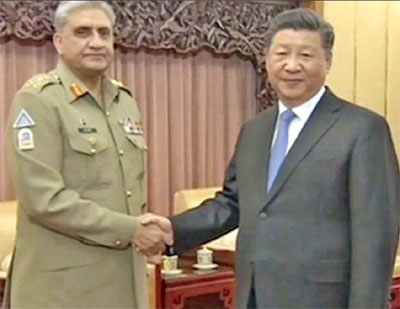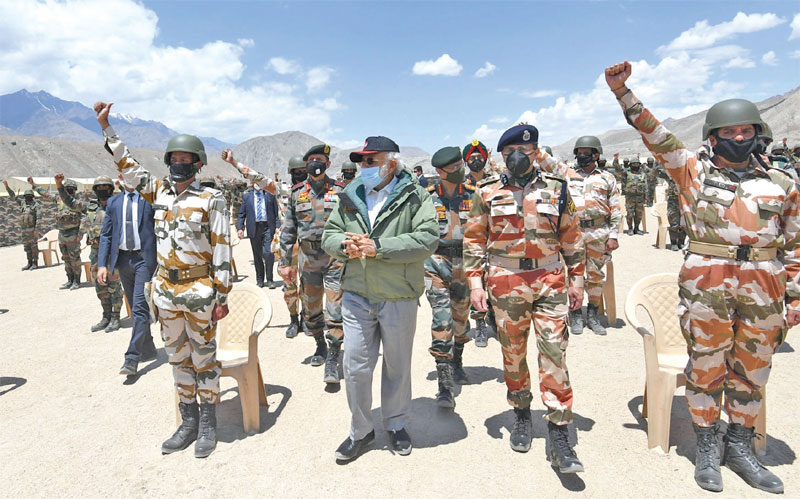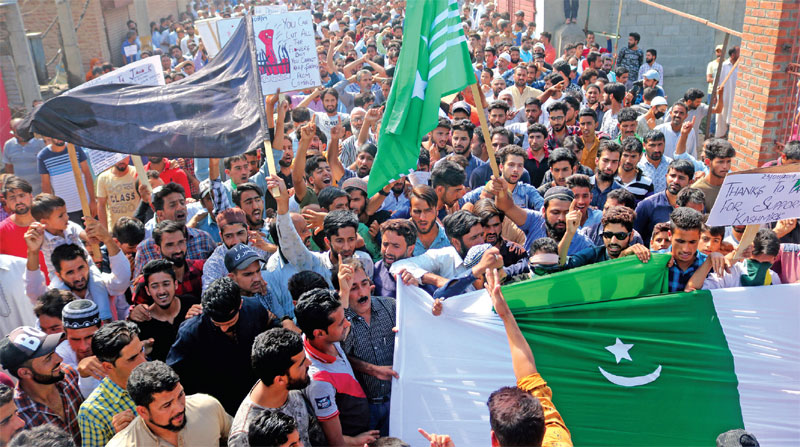By turning LC into a soft border, the Modi government can finally do what none could in the past
Pravin Sawhney
Pakistan army chief, Gen. Qamar Javed Bajwa seems ready to pick up the conversation with India which was interrupted by Gen. Pervez Musharraf’s ouster in 2008. What’s more, he is happy to do so under Musharraf’s four-point formula on Kashmir. Very senior serving Pakistan army officer whom I met on the second day of the Islamabad Security Dialogue (ISD), which I attended as a speaker, said this to me in no uncertain terms.

Interestingly, the previous day, Moeed Yusuf who was then still the national security advisor said the same thing in an informal interaction with me. According to him, the Musharraf formula could be the basis of bilateral interaction between India and Pakistan. Moeed has since resigned once the dissolution of the national assembly was ordered by the Pakistan President.
In his keynote address on April 2, Gen. Bajwa said that he wanted good relations with India because ‘Pakistan will benefit if we improve ties with India.’ Holding up the Line of Control as an evidence of Pakistan’s sincerity, Gen. Bajwa said that it ‘has been peaceful since a year’, a fact corroborated by the Indian army chief, Gen. M.M. Naravane on several occasions in the last few months.
‘Since Pakistan’s concern are its people, we want to put the money where the mouth is. Today, Pakistan stands on the crossroad of its economic and strategy goals. It has north-south connectivity (Pakistan to Afghanistan to Central Asian Republics and Russia). We want to build connectivity from east to west (India to Iran). This will increase trade and benefit Pakistan and the region. We want to move from geostrategy to geoeconomics and make Pakistan a modern and forward-looking country.’
To my question on how he intended to realise his vision, Gen. Bajwa said, ‘It is time (for India and Pakistan) to move on. Let us sit down and resolve our issues including Kashmir… We want development first’.
According to Gen. Bajwa, Pakistan military spends USD eight to nine billion annually on defence and has 5,38,000 strong army. ‘We have done a study whereby we can reduce the army substantially over next five years.’ The money saved could be used for modernisation of firepower and cyber security, he said.
Following Gen. Bajwa’s talk, I spoke with two senior serving army officers, attending the ISD, for clarity on what he had said. According to them, Pakistan was willing to start the bilateral talks under the ‘Musharraf formula’ which was proposed to Prime Minister Manmohan Singh. The senior of the two said that since both India and Pakistan are nuclear-weapon powers, neither can take the territory in other’s control by force. Hence, the answer lies in holding a sincere dialogue on Kashmir.

‘Just as India and China hope to resolve their border dispute peacefully, we should do the same with overall improvement in relations,’ he said.
On my specific question on the revocation of Article 370, the officer said that the change of constitutional status of Jammu and Kashmir did not matter to Pakistan since it in any case did not recognise Article 370 of the Indian Constitution. However, the reading down of Article 35A which can lead to demographic changes in the Kashmir Valley was a matter of concern.
‘Once we start talking, both sides could address this issue amicably,’ he said.
Apparently, Gen. Bajwa has been inspired by China’s general secretary Xi Jinping. In their first meeting, Xi is supposed to have told Bajwa that China waited 98 years to get Hong Kong back from the British and 103 years for Macau to revert to China from Portugal. But this did not detract China from working for the economic development of the nation and uplift of the people.
Gen. Bajwa recounted this conversation to his senior staff, the officer told me, because it resonated with him. But will it resonate with his successor too or is he hoping to get another extension?
Bristling a bit, my interlocutor insisted that there has been continuity in Pakistan army’s position on Kashmir for several years now. What’s more, Pakistan’s first National Security Policy (NSP) made by the hybrid government of Imran Khan and Gen. Bajwa emphasizes upon human security, which is nation’s development and prosperity, instead of merely traditional defence. Interestingly, the NSP has been written by National Security Division which has a constitutional status in Pakistan. With the army as a part of the NSP, any new government in Pakistan would have to abide by it, and that includes peace talks with India.

Given this, ‘If the LoC becomes a soft border, the people of the two Kashmirs would be able to interact and trade freely. Bilateral trade and normalisation of relations between India and Pakistan could then follow,’ he said.
The Musharraf formula, in brief, had four points: One, both sides (India and Pakistan) identify regions that need resolution. Two, demilitarize the identified regions which will help bring down the level of violence. Three, introduce self-governance or self-rule in the identified region/s. And four, have a joint management mechanism with membership consisting of Indians, Pakistanis, and Kashmiris overseeing self-governance and dealing with subjects common to all identified regions that are beyond the scope of self-governance.
Pakistan, and especially its army leadership, seems greatly inspired by China’s economic rise and believes that Pakistan can benefit enormously from the China-Pakistan Economic Corridor (CPEC) which is the flagship of Xi’s dream project called the Belt and Road Initiative. Phase two of the CPEC which was signed between Pakistan and China in February this year revolves around the creation of special economic zones, industrialization, and information technology with Gwadar deep-sea port as regional connectivity hub. It is hoped that within five years, with Chinese help, Gwadar will be connected to Nepal, Afghanistan, the Central Asian Republics (Kyrgyzstan, Tajikistan, Uzbekistan, Turkmenistan, and Azerbaijan), Kuwait, Bahrain, Qatar, Saudi Arabia, Iran, United Arab Emirates, and Oman.
Meanwhile, the third and fourth industrial revolutions could be ushered in simultaneously. Work on the third industrial revolution which involves hard cyberspace connectivity by fibre optic cables, subsea cables, Huawei 5G wireless connections, and BeiDou satellite navigation system (with special resolution rights for Pakistan) would be carried forward under CPEC Phase two. The fourth industrial revolution which is about Artificial Intelligence (AI), and data has already begun in Pakistan. Data centres are being created with the help from Chinese companies and a national nodal agency for AI and its applications called the Centre of Artificial Intelligence and Computing (CENTAIC) was established in August 2020 under the Pakistan Air Force. To accomplish all this, Pakistan needs peace with India.
What if all of this is strategic rhetoric by Pakistan to bolster its global image?
This seems unlikely given the effort put in by both Pakistan and its strategic mentor, China, to kickstart talks between India and Pakistan. Both are cognisant of the fact that with a majority in the Indian Parliament, Prime Minister Narendra Modi can do what his predecessor, Manmohan Singh could not. In any case, by holding Pakistan to its words, the reality would become apparent in little time.

What does India get in return? If the LoC becomes a soft border, India’s two front war strategy and the Cold Start doctrine against the Pakistan Army which has not been war-gamed will not be put to test. The Jammu and Kashmir union territory will achieve normalcy and the Indian Army would not need to do counter-terror operations. CT ops have taken a heavy toll on Indian lives and military’s professionalism. The Rashtriya Rifles numbers could be cut down substantially; even the Indian Army strength could be reduced. With the ensuing savings, India could invest in emerging dual use technologies and on China. Seen this way, peace with Pakistan would be a win-win not only for the two nations, but for the region.
However, if India continues to stonewall these peace overtures and tries to improve bilateral ties with China alone, the problem of the two military lines will not go away. It would still need to maintain round the clock vigil on the Line of Actual Control since Tibet Autonomous Region and Xinjiang is People’s Liberation Army’s permanent habitat. Additionally, Indian military will need to cater for the Line of Control with Pakistan which can switch to ‘hot war’ from ‘cold peace’ at short notice. And Kashmir would remain restive.
Many cynics say that with the LoC resolved, the Pakistan Army would lose its importance. This will not happen. Subsequent to the nuclear tests of 1998, the Pakistan Army has been in control of its nation’s foreign policy in addition to its security and defence policies. With nuclear weapons and policy under its control, the Pakistan Army’s domestic and international stature has gone up. For example, in the outgoing Imran Khan government, the Prime Minister did not favour close ties with the US. Khan accused the US of instigating regime change in Pakistan since he had refused to provide the US military bases in Pakistan for use against Afghanistan. Gen. Bajwa, on the other hand, said at the ISD that Pakistan should have good ties with both China and the US. Moreover, unlike Khan, the army chief was not too enthused about close ties between Pakistan and Russia which was anathema to the US. In the end, the Pakistan Army prevailed; by adopting a neutral stance, as claimed by it, Khan was ousted by Shehbaz Sharif as the Prime Minister by the numbers game in the Parliament.
On assuming office, Sharif lost no time in reaching out to Modi for peace between the two nations. With Modi congratulating Pakistan’s new Prime Minister, and with the ceasefire holding on the LC since February 2021, the stage may be set for peace between India and Pakistan.

